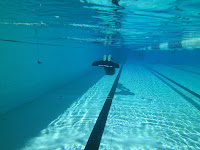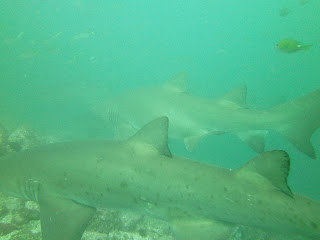Introduction:
Have you ever met a freediver? If you have, you may have noticed that they're a proud bunch. In a lot of cases - even more so than many scuba divers. Like me - did you ever wonder why? As the owner of Dive Flag App I was approached by a high number of freedivers - asking me to include more freediving content on; Dive Flag App, Dive Flag App's Facebook Page and on Dive Flag App's website. I was not comfortable in doing so without knowing exactly what I was promoting or talking about. Thus, I began my journey to learn about freediving.
Freediving can be defined as 'a form of underwater diving that relies on a diver's ability to hold his or her breath until resurfacing'. This differs from scuba diving where the diver makes use of a self contained underwater breathing apparatus to continually breath whilst submerged. Freediving techniques are used in a multitude of sports including, but not limited to; breath-hold spear fishing, freedive photography, recreational breath-hold diving, mermaid shows, and to some degree, snorkeling.
Fortunate for me I have access to one of Australia's leading and most accomplished freedive instructors - Amber Bourke of the Snorkel Safari group. Amber recently competed in Serbia at AIDA and returned with a bronze medal and three new Australian records. Amber is a freediving instructor for Scuba Schools International (SSI). Over two days I will be taught both Basic & Level 1 freediving courses. Hopefully I will find out what the craze is all about.
Freediving can be defined as 'a form of underwater diving that relies on a diver's ability to hold his or her breath until resurfacing'. This differs from scuba diving where the diver makes use of a self contained underwater breathing apparatus to continually breath whilst submerged. Freediving techniques are used in a multitude of sports including, but not limited to; breath-hold spear fishing, freedive photography, recreational breath-hold diving, mermaid shows, and to some degree, snorkeling.
Unlike scuba diving anyone can attempt to freedive - regardless of age. However, not everyone can manage to successfully freedive right away. Freediving is about practice, rhythm and being in tune with your body's physical processes.
About SSI's Free Diving:
As I previously mentioned freediving is about practice and progression. SSI have broken free diving down into the following four main levels. Each level progresses you through a series of new skills and increased limits.
Freediving (Basic)
Freediving (Level 1)
Freediving (Level 2)
Freediving (Level 3)
My Free Dive Experience:
The course's manual is entitled 'Freediving Level 1 & 2' by SSI. The manual outlines gear selection tips, the physiology of diving, beginner freediving skills and what you can expect to encounter in your freediving environment.
Day 1
We met at Snorkel Safari Brisbane - on the first day. After receiving a quick introduction which outlined the course structure and requirements Amber asked some general questions which highlighted ultimately why each of us were interested in learning to freedive.
Other group member responses included:
- "I have never tried scuba diving. I am interested in trying freediving first."
- "We have a holiday coming up where we will have the opportunity to free dive with whale sharks. Which we believe allows us to get closer than scuba diving."
- "I am a scuba diver branching out to see what freediving is about."
In the above video Amber introduces Dive Flag App members to the Level 1 pool training (basic) skill set. We commenced by performing a series of stretches which prepared us for the day's session. This included shoulder, back, lats and leg stretches.
Once we completed the stretching routine we practiced some breathing techniques. The breathing techniques focused on reducing our heart rates, also, clearing our minds and allowing us to feel the physiological responses our body goes through when holding our breath. The aim of freediving is of course to conserve oxygen by moving through the water with as little effort as possible.
Holding your breath underwater may sound difficult and unnatural but the human body has several adaptations which enable the your body to endure depth and lack of oxygen far beyond what one would assume is possible. These adaptations are covered by the term: mammalian diving reflex.
- Reflex bradycardia: Drop in heart rate.
- Vasoconstriction: Blood is directed away from the limbs and into the torso.
- Splenic contraction: The releasing of red blood cells carrying oxygen into the circulatory system.
- Blood shift: Blood plasma fills up blood vessels in the lung, which reduces residual volume.
Once in the pool we combined our new breathing techniques with the before mentioned affects of the mammalian dive reflex. I was able to hold my breath for just over 2 minutes on my first 'static hold'. This surprised me.
Then we practiced our breath holds whilst swimming underwater.
After everyone completed their 30 meter minimum requirement in underwater kicking distance, on a single breath, we were required to achieve the same distance by using only our arms.
After these drills, Amber demonstrated how the monofin freediving style differs from that with two fins.
After completing all our basic pool training - we returned to Snorkel Safari Brisbane to sit a quick exam. The exam tested us on the theory in the training manual. After completing the exam we were briefed on the structure of day two which is outlined below.
Day 2
Once we arrived at Cook Island we set up two Neptune Freediving Buoys. These buoys were linked to the back of an anchored boat - at a spot with a maximum depth of 12 meters. The first buoy was used solely as the resting buoy. This allowed us to conserve our energy and maintain a low heart rate between dives. When it was our turn to freedive we swam to the second buoy and performed a head first dive / duck dive with a spotter (dive instructor) the whole way.
The first requirement was a duck dive to a maximum depth of 5 meters. Once we had all successfully reached 5 meters we advanced to a 10 meter target. Below is a video of Amber spotting a freediving student during their 10 meter descent.
On two rest breaks we had a pod of dolphins swim nearby. It was incredibly fortunate for us that on our first day of freediving we were able to do so with dolphins. They didn't stay around us for very long but it was still a great experience to see them underwater.
Once we all reached the 10 meter target depth we performed the same drill with only our arms and then as a safety drill (recovering a buddy from the bottom). Below is a photo of the Neptune Freediving Buoy equipment used on day two of the course:
Available for purchase from: Dive Import Australia
Dive Flag App's Overall Review:
The Level 1 SSI freediving course was a lot of fun. As we all know - the quality of your learning experience can be influenced greatly by your instructor. SSI make use of the best possible trainers which adhere to their strict international standards. Amber was vibrant, helpful and contagiously happy. The course was quick but comprehensive. After completing the course I feel prepared enough to practice freediving with my buddies.
The book was helpful, easy to read and most importantly was compiled by industry experts. A lot of dive related books waffle on and are very repetitive. This book got straight to the point and as such felt like a breeze to read.
The book was helpful, easy to read and most importantly was compiled by industry experts. A lot of dive related books waffle on and are very repetitive. This book got straight to the point and as such felt like a breeze to read.
Smaller class numbers always allow for a more personalized learning experience. As such SSI limit their freediving class numbers to four students per instructor. This ensures that everyone is given enough opportunity to try and retry skills without feeling pressured to rush through them. This is very important when trying freediving.
Furthermore, I would highly recommend showing some professional freediving videos in-class which highlight the more extreme possibilities of freediving. I believe this would motivate and excite more students to continue through each levels. These videos and perhaps photos would entice more people to strive harder to reach the limits and further their training.
Below are some reasons why you should try free diving:
- Animals come in closer to you when you are not breathing out loud bubbles,
- You learn important breathing and relaxation techniques which not only improve your scuba diving but which can also be used in your normal day-to-day environment,
- Freediving expands the number of activities you can participate in on your next dive trip / holiday, and
- Having completed the course you are more proficient in assisting someone who is over come by loss of motor control or blackouts underwater.
I highly recommend SSI freediving courses - to everyone. I will be contacting Snorkel Safari Brisbane soon to book in my level two training session.
Over score: 10/10
Dive Flag App
Owner
info@diveflagapp.com















































.JPG)



.JPG)






























